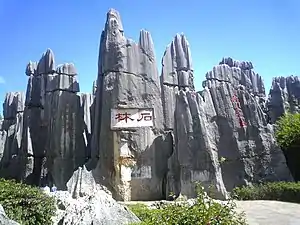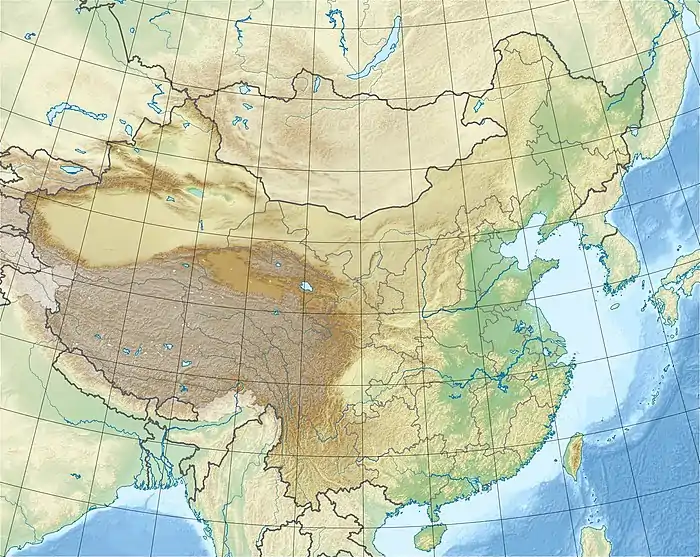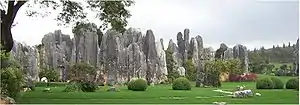| UNESCO World Heritage Site | |
|---|---|
 Stone Forest (Shilin Karst in Yunnan) | |
| Location | China |
| Criteria | Natural: (vii), (viii) |
| Reference | 1248bis |
| Inscription | 2007 (31st Session) |
| Extensions | 2014 |
| Coordinates | 24°55′24″N 110°21′16″E / 24.92333°N 110.35444°E |
 Location of South China Karst in China | |
The South China Karst (simplified Chinese: 中国南方喀斯特; traditional Chinese: 中國南方喀斯特; pinyin: Zhōngguó Nánfāng Kāsītè), a UNESCO World Heritage Site since June 2007,[1] spans the provinces of Chongqing, Guangxi, Guizhou, and Yunnan. It is noted for its karst features and landscapes as well as rich biodiversity. The site comprises seven clusters Phase I: Libo Karst, Shilin Karst, and Wulong Karst inscribed in 2007, and Phase II: Guilin Karst, Shibing Karst, Jinfoshan Karst, and Huanjiang Karst inscribed in 2014.[2] UNESCO describes the South China Karst as "unrivalled in terms of the diversity of its karst features and landscapes."[1]
The huge karst area of South China is about 550,000 km2 in extent. The karst terrain displays a geomorphic transition as the terrain gradually descends about 2000 meters over 700 kilometers from the western Yunnan-Guizhou Plateau (averaging 2100 meters elevation) to the eastern Guangxi Basin (averaging 110 meters elevation). The region is recognized as the world’s type area for karst landform development in the humid tropics and subtropics.
The World Heritage Property of South China Karst is a serial property that includes seven karst clusters in four Provinces: Shilin Karst, Libo Karst, Wulong Karst, Guilin Karst, Shibing Karst, Jinfoshan Karst, and Huanjiang Karst. The total area is 97,125 hectares, with a buffer zone of 176,228 hectares.
The South China Karst World Heritage property protects a diversity of spectacular and iconic continental karst landscapes, including tower karst (fenglin), pinnacle karst (shilin) and cone karst (fengcong), as well as other karst phenomena such as Tiankeng karst (giant dolines), table mountains and gorges. The property also includes many large cave systems with rich speleothem deposits. The karst features and geomorphological diversity of the South China Karst are widely recognized as among the best in the world. The region can be considered the global type-site for three karst landform styles: fenglin (tower karst), fengcong (cone karst), and shilin (stone forest or pinnacle karst).The landscape also retains most of its natural vegetation, which results in seasonal variations and adds to the outstanding aesthetic value of the area.
The property contains the most spectacular, scientifically significant and representative series of karst landforms and landscapes of South China from interior high plateau to lowland plains and constitutes the world’s premier example of humid tropical to subtropical karst: one of our planet’s great landscapes. [2]
South China Karst - UNESCO inscription details
| UNESCO Inscription No | Name |
|---|---|
| 1248-001 | Shilin Karst - Naigu Stone Forest (乃古石林) |
| 1248-002 | Shilin Karst – Suogeyi Village (所各邑村) Shilin Yi Autonomous County |
| 1248-003 | Libo Karst – Xiaoqijong (小七孔) Libo County |
| 1248-004 | Libo Karst – Dongduo (洞多) Libo County |
| 1248-005 | Wulong Karst – Qingkou Giant Doline (Tiankeng) (箐口天坑) |
| 1248-006 | Wulong Karst – Three Natural Bridges (天生三桥) Wulong County |
| 1248-007 | Wulong Karst – Furong Cave (芙蓉洞) Wulong County |
| 1248-008 | Guilin Karst – Putao Fenling |
| 1248-009 | Guilin Karst – Lijiang Fengcong
Yangshuo County |
| 1248-010 | Shibing Karst |
| 1248-011 | Jinfoshan Karst |
| 1248-012 | Huanjiang Karst |
Gallery
South China Karst.
 The Shilin (Stone Forest) South China Karst formations scenery
The Shilin (Stone Forest) South China Karst formations scenery Karst limestone stalactites in the Furong Cave.
Karst limestone stalactites in the Furong Cave. Tianlong Bridge, a South China Karst natural arch.
Tianlong Bridge, a South China Karst natural arch.
References
- 1 2 "Twenty-two new sites inscribed on UNESCO's World Heritage List, and one deleted during Committee meeting in Christchurch". UNESCO World Heritage Convention. 29 June 2007. Retrieved 2011-02-14.
- 1 2 "South China Karst". UNESCO.
